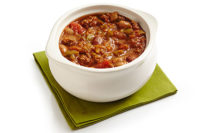In a perfect world, everyone’s cholesterol and credit levels would be right where they needed to be, and consumers could enjoy their meals without any outside interference. Unfortunately, the wallet and the waistline have as much say in what consumers eat as the latest taste trends from overseas or the newest recipe from a cable TV cooking show.
In spite of those constraints, this is a wonderful time to be a foodie. The proliferation of ethnic restaurants and creative chefs gives consumers the opportunity to try foods from around the world — or prepare them in their own kitchens, if they’re feeling particularly brave. With regard to chicken alone, Laura McGuire, senior content and editorial manager for Technomic, says that chefs are experimenting with unconventional ethnic preparations, including Indonesian, African-Portuguese fusion, Peruvian and Lebanese influences.
“Asian-inspired fried chicken, also trending up, can be found at BonChon, an emerging chain from South Korea that menus authentic, Korean-style fried chicken,” she says.
Restaurants are also experimenting with the versatility of turkey, she adds. While the ever-growing health trend is driving interest in turkey burgers and sliders, restaurants may be introducing appetizers such as nachos with barbecued pulled turkey and barbecue salads with turkey.
McGuire notes that fast-casual restaurants continue to be a high-growth segment. Over the last three years, that segment in particular has seen a strong bump in both sales and units in the United States (see chart). Fine dining restaurants also enjoyed growth in the last year, and McGuire says she expects another good year ahead.
Red meat continues to be a staple of restaurant menus, though the rising cost of beef has led to some changes in the way it is served. McGuire says there is a rising interest in the low-cost cuts of beef, such as ribeye, skirt steak, flank steak, shoulder and brisket.
“We may also see more movement toward beef substitutes, including bison,” she adds, noting that the casual-dining chain Original Roadhouse Grill offers a bison ribeye and a bison back ribs dinner. The full-service Silver Diner chain lists a local, farm-raised bison chopped steak entrée as well. Roam Artisan Burgers, which has two locations in San Francisco, offers diners the choice of burger patties that include beef, bison, veggie, turkey or elk.
“We could also see operators substituting meat and poultry for lobster, due to the lower price for this marine crustacean,” McGuire adds.
Health and price concerns at retail
Not all trends relate to world cuisine or flavors, however. Rising protein prices have had an effect at the meat case and have altered consumers’ buying options. According to Fresh Look Marketing, for the 52 weeks ending on Aug. 25, 2013, the average retail price for the total meat category has increased 2.1 percent over the previous year. Chicken prices increased the most, at 5.4 percent, and beef costs were up 3.4 percent; the cost of pork, on the other hand, decreased by 3.3 percent.
Michael Uetz, principal at Midan Marketing, noted that those increases in prices led to some fluctuation in sales.
“Beef volume sales decreased by 0.9 percent during this time period, while fresh pork volume actually increased 4.8 percent,” he says.
Rising meat prices — or at least the perception of rising meat prices — have led to decreased consumption of red meat. Mintel reported that 39 percent of consumers are eating less red meat in 2013 than in 2012, and the cost of meat was given as the No. 2 reason why, with 36 percent of those surveyed reporting it.
The top reason consumers are eating less meat in 2013 (cited by 57 percent) is they are trying to eat healthier. Another 32 percent say they are eating less meat because they are watching their cholesterol.
“The trend of declining consumption of red meat is expected to continue into the foreseeable future, due to persistent health concerns,” said Sarah Day Levesque, food and drink analyst at Mintel. “In general, we expect that consumers will continue to demand healthier cuts of meat, and therefore consumption of leaner cuts may increase.”
|
Get more of the story online Sam Gazdziak sits down with Trevor Amen, director of market intelligence for the National Cattlemen’s Beef Association, to discuss opportunities for beef products in the retail and foodservice sectors. Also, Editorial Board member Dan Emery discusses the constantly changing consumer in his Business Strategies column this month. |
In addition to searching for products that are low in fat or cholesterol, more consumers have demanded gluten-free items. However, demand for gluten-free is not limited to the gluten-intolerant population. Mintel reports 65 percent of consumers who eat or used to eat gluten-free foods do so because they believe those products are healthier for them. Another 27 percent reported that they eat gluten-free products because they believe the food aids in weight-loss efforts.
Even though there is no research supporting those beliefs, the gluten-free food and beverage market is estimated to reach $10.5 billion in sales in 2013, reports Mintel.
“The view that these foods and beverages are healthier than their gluten-containing counterparts is a major driver for the market, as interest expands across both gluten-sensitive and health-conscious consumers,” says Amanda Topper, food analyst at Mintel.
Along with the desire to eat better, some Americans are changing their dietary habits in an effort to eliminate medical bills. Uetz adds that the recession led to not only a loss of income for many people, but a loss of health insurance as well. Many Americans learned the true cost of being sick during that time, he says.
“Today, there’s a monetary influence that is a new driver of healthy eating,” he says. “Consumers are proactively managing their health by shifting from what they should do to what they must do to avoid the financial liability of health care in the future.”
Midan’s research indicates that 69 percent of consumers focus more on their health compared to three years ago, and 49 percent of them say they are doing so to keep medical costs down. Uetz points out that fresh meat is the best natural source of many nutrients, including protein, iron and zinc, and consumers need help in understanding that.
“Retailers need to educate their customers about the nutritional value of fresh meats, portion sizes and the benefits of serving fresh meats to their families,” he says. “Those who educate their customers on making healthy decisions will reap the benefits later.”
Whether it is due to prices or health concerns, consumers who are buying less beef are turning to poultry and pork products as alternatives at the retail level, says McGuire from Technomic. That could include products like chicken sausage, turkey bacon and turkey burgers.
“A spin on this trend that could grow over the next year is to sell poultry with ethnic twists,” she says. “For instance, Cargill offers a Pride of the Farm[-branded] turkey chorizo, and Evergood Fine Foods, Logan’s Sausage, Aidells and al fresco all offer chicken chorizo.”
Value-added products, such as pre-marinated meats or meal kits, continue to attract consumer interest, particularly among the male demographic. Levesque notes that 19 percent of men buy beef and other red meat products that have been partially prepared for them, such as hamburger patties or kabobs, compared to 16 percent of overall beef and red meat consumers.
She points out that new product launches in the red meat category from 2008-2013 have focused strongly on flavor innovation and added convenience — creating flavors consumers can’t easily make at home or that emulate what consumers experienced at a restaurant.
“For example, Butcher’s Best Smokey BBQ Flavored Pork Kabobs offer consumers flavored pork that is in a format not otherwise readily available,” she says. “Tyson Slow Cooked Beef Pot Roast in Gravy makes preparing a more extravagant main dish as easy as popping the product in the microwave, and Pace Carnitas Slow Roasted Pork offers restaurant-style carnitas at home.”
The youngest group of adult consumers, 18-24 year olds, is twice as likely (32 percent) as the average consumer to buy beef and pork products that have been partially prepared for them, Levesque adds.
“This significantly higher purchase rate can be explained by this are group’s tendency to have a smaller skill set for cooking due to lack of experience,” she explains.
Uetz stresses the need for retailers and processors to continue educating consumers on the various cuts of fresh meat and how to prepare them. He notes that consumers are open to direction while shopping the meat case, so on-pack labels — still the preferred method — or signage available with cooking information can help consumers understand how to prepare the products they are purchasing.
“This is even more critical now, as prices continue to increase, and consumers are hesitant to purchase an unfamiliar cut of meat and risk having a less-than-satisfying meal,” he says.
Food giants Walmart and Tyson Foods have tried to provide that help to consumers with a new line called Mix & Match Creations meal options. Touting the ability to feed a family of four starting at $10, the Creations products meet the needs of providing preparation instructions for a good meal at an economical price.
Mix & Match Creations products allow consumers to create customized meals made by combining one of five premium Tyson proteins, one of eight family-sized servings of frozen Birds Eye vegetables and/or starch, and one of six TysonBistro Flavors complementing sauces that tie meals together in a delicious, satisfying way. There are 76 unique meal combination possibilities, from Sautéed Beef with Bourbon Peppercorn sauce and Mixed Vegetables or Breaded Chicken served with White Rice with an Orange Teriyaki Glaze.
The layout of the freezer display case for Mix & Match Creations products and color-coded packaging (red for meat, blue for sides and green for sauces) take the guesswork out of dinner planning, Tyson says.
Levesque says that the meat industry has an opportunity to invigorate the market with new products, improved quality and improved functionality.
“The industry has done little to innovate since the recession and therefore has offered consumers little to get excited about,” she states. “Red meat can be positioned as an indulgence worth a higher price tag to get higher quality. Meat producers can appeal to those indulging in red meat with different production methods such as grass-fed or organic products, or with entirely new cuts of meat.
“For those consumers for which premium products do not appeal, producers can offer more convenient and functional packaging that provides portion control and better ease of use,” she adds.









Report Abusive Comment